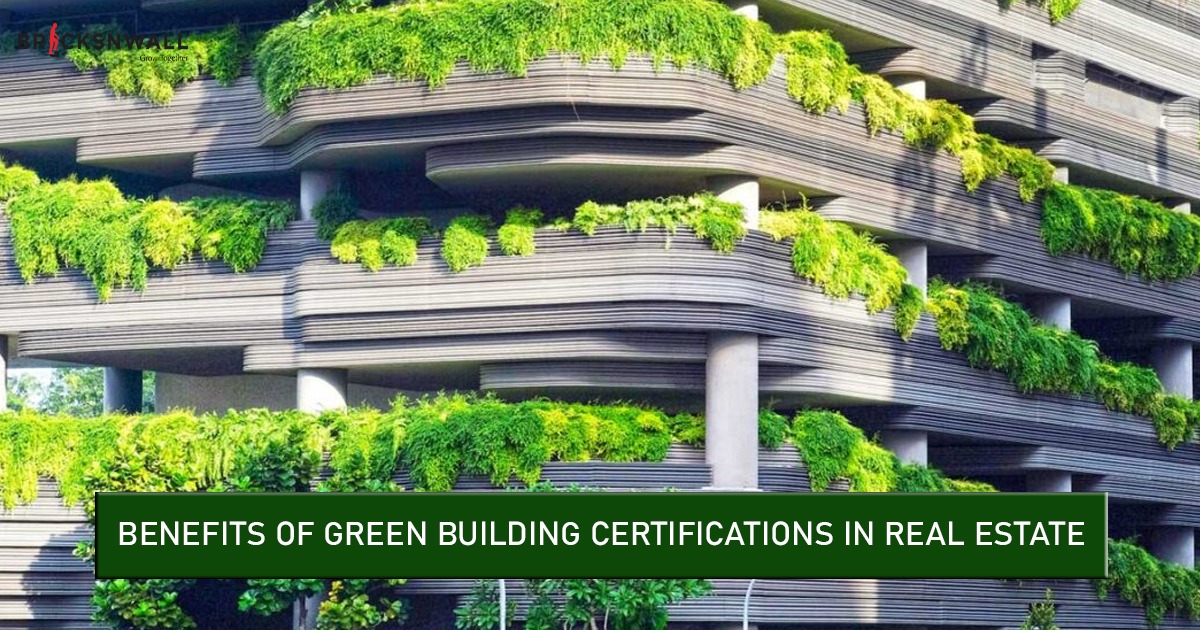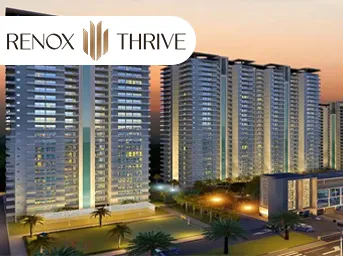Benefits of Green Building Certifications in Real Estate
Bricksnwall Trusted Experts

How Getting Certified Can Improve Your Bottom Line
For property managers seeking for methods to
enhance revenue and reduce costs, there are numerous options that may or may
not deliver value to their renters. However, one approach to add value while
increasing revenue and minimising costs is to have your property certified as a
green building.
While gaining a green certification may appear to
be an expensive and time-consuming endeavour, green certifications are becoming
increasingly popular among tenants. And it's frequently simpler than many
people assume, and even with a few minor changes to existing structures, you
could be qualified for certification. Any level of accreditation can provide
significant advantages for property managers.
Some of the advantages include:
1. An advantage over the competitors
While many businesses have returned to the office,
more are operating in smaller premises, as remote and hybrid work remains a
driving factor in employment. Vacancy rates in commercial real estate have
remained high, despite expectations that they will eventually recover. This
means that commercial tenants have more options than ever before, and with so
much competition, particularly in major cities, you must stand out.
Commercial renters are increasingly demanding
cleaner, more environmentally friendly, and healthier workplaces. Wellness and
sustainability, particularly in the aftermath of the pandemic, are two of the
most important factors for occupiers to consider. By providing assurances of
these things through certification, you will have an advantage over other
buildings.
2. Charging higher rents
According to a 2018 assessment by the World Green
Building Council, commercial workplaces located in certified buildings had
better overall employee health, increased productivity, and higher job satisfaction.
Because these are considered premium features, property managers may charge
higher market rates for these buildings.
In fact, JLL discovered that in the APAC region,
seven out of ten enterprises were willing to pay more for green-certified
buildings.. So, even if certain changes are required upfront to become
accredited, the long-term returns on investment will be higher.
3. Reduced vacancy rates
In addition to higher rents, green-certified
buildings have lower vacancy rates than the entire market. Most of this is due
to the two benefits described above: a better working environment and fewer
green buildings in a city.
Tenants in green-certified buildings are more
likely to renew their leases and stay for longer periods of time. This leads to
fewer tenant transitions and less time spent in vacant office premises, both of
which have an influence on the bottom line.
4. Reduce operating costs
While greening a building may require an initial
investment, it can result in long-term savings as operating expenses fall
dramatically. This results from more efficient design systems and their
lifetime. Replacing outmoded heating systems with cleaner, greener heating
systems, for example, will last longer, cost less, and require less
maintenance.
Even minor improvements like these can have a
significant influence on the bottom line while also assisting a facility to
achieve certification requirements.
5. Increased efficiency
A green building certification evaluates a variety
of aspects, including energy efficiency and waste management. Having top-notch
systems in place will make your job easier, reduce tenant complaints, and save
money.
For example, energy-efficient lights will last
longer and require fewer adjustments, saving you time, whilst streamlined
recycling systems result in fewer waste levy changes and improved overall waste
efficiency.
6. Reduce emissions
Commercial real estate accounts for 39% of
worldwide greenhouse gas emissions, with 11% coming from the construction of
new buildings and the remainder from the structures and energy themselves.
However, green buildings contribute less to global carbon emissions overall.
Compared to traditional structures, there are 50% fewer greenhouse gas
emissions from water usage and 48% fewer from trash.
This benefits the environment, the communities
surrounding your facilities, and your overall brand reputation. Lowering your
building's carbon footprint contributes to a more sustainable future.
7. Governments push for it
With more countries advocating for greener
communities and net zero emissions, many governments are attempting to impose
stricter building rules. In New Zealand, all new government buildings must
satisfy a minimum Green Star rating. While these criteria are now only
applicable to government buildings, many people expect that they will be
extended to all commercial buildings in the future.
Because governments recognise the significance and
costs of these new regulations, many communities have incentivised building
owners to go green. These include funding options, tax breaks, and
public-private partnerships to help create new green buildings or renovate existing
ones. While these incentives differ by country or state, property managers can
use them to assist offset some of the costs associated with Making a building
greener.
In Summary
While the future is unknown, becoming green
certified will put your building in a much better position to deal with future
environmental and economic volatility. It can lower running expenses, make your
building more appealing to renters, and keep occupancy rates at a higher rental
price. Greening your building is an excellent method to lower your overall
environmental footprint while also demonstrating to investors, stakeholders,
and building occupiers your commitment to the future.
1. An advantage over the competitors
While many businesses have returned to the office,
more are operating in smaller premises, as remote and hybrid work remains a
driving factor in employment. Vacancy rates in commercial real estate have
remained high, despite expectations that they will eventually recover. This
means that commercial tenants have more options than ever before, and with so
much competition, particularly in major cities, you must stand out.
Commercial renters are increasingly demanding
cleaner, more environmentally friendly, and healthier workplaces. Wellness and
sustainability, particularly in the aftermath of the pandemic, are two of the
most important factors for occupiers to consider. By providing assurances of
these things through certification, you will have an advantage over other
buildings.
2. Charging higher rents
According to a 2018 assessment by the World Green
Building Council, commercial workplaces located in certified buildings had
better overall employee health, increased productivity, and higher job
satisfaction. Because these are considered premium features, property managers
may charge higher market rates for these buildings.
In fact, JLL discovered that in the APAC region,
seven out of ten enterprises were willing to pay more for green-certified
buildings.. So, even if certain changes are required upfront to become
accredited, the long-term returns on investment will be higher.
3. Reduced vacancy rates
In addition to higher rents, green-certified
buildings have lower vacancy rates than the entire market. Most of this is due
to the two benefits described above: a better working environment and fewer
green buildings in a city.
Tenants in green-certified buildings are more
likely to renew their leases and stay for longer periods of time. This leads to
fewer tenant transitions and less time spent in vacant office premises, both of
which have an influence on the bottom line.
4. Reduce operating costs
While greening a building may require an initial
investment, it can result in long-term savings as operating expenses fall
dramatically. This results from more efficient design systems and their
lifetime. Replacing outmoded heating systems with cleaner, greener heating
systems, for example, will last longer, cost less, and require less
maintenance.
Even minor improvements like these can have a
significant influence on the bottom line while also assisting a facility to
achieve certification requirements.
5. Increased efficiency
A green building certification evaluates a variety
of aspects, including energy efficiency and waste management. Having top-notch
systems in place will make your job easier, reduce tenant complaints, and save
money.
For example, energy-efficient lights will last
longer and require fewer adjustments, saving you time, whilst streamlined
recycling systems result in fewer waste levy changes and improved overall waste
efficiency.
6. Reduce emissions
Commercial real estate accounts for 39% of
worldwide greenhouse gas emissions, with 11% coming from the construction of
new buildings and the remainder from the structures and energy themselves.
However, green buildings contribute less to global carbon emissions overall.
Compared to traditional structures, there are 50% fewer greenhouse gas
emissions from water usage and 48% fewer from trash.
This benefits the environment, the communities
surrounding your facilities, and your overall brand reputation. Lowering your
building's carbon footprint contributes to a more sustainable future.
7. Governments push for it
With more countries advocating for greener
communities and net zero emissions, many governments are attempting to impose
stricter building rules. In New Zealand, all new government buildings must
satisfy a minimum Green Star rating. While these criteria are now only
applicable to government buildings, many people expect that they will be
extended to all commercial buildings in the future.
Because governments recognise the significance and
costs of these new regulations, many communities have incentivised building
owners to go green. These include funding options, tax breaks, and
public-private partnerships to help create new green buildings or renovate
existing ones. While these incentives differ by country or state, property
managers can use them to assist offset some of the costs associated with Making
a building greener.
In Summary
While the future is unknown, becoming green
certified will put your building in a much better position to deal with future
environmental and economic volatility. It can lower running expenses, make your
building more appealing to renters, and keep occupancy rates at a higher rental
price. Greening your building is an excellent method to lower your overall
environmental footprint while also demonstrating to investors, stakeholders,
and building occupiers your commitment to the future.
- Businesses using certified buildings can benefit from reduced maintenance expenses, improved efficiency, and lower rates of energy and water usage.
- A Knight Frank survey indicates that certified green buildings in India are 7–10 percent more expensive to rent than non-certified ones. This, combined with long-term energy savings and growing demand, makes green certifications a huge advantage for property owners.
- You can obtain LEED Platinum (the highest rating), LEED Silver, LEED Gold, or LEED Certified based on the total number of points you earn from each green building component.
- he activity of creating, constructing, and managing buildings in an environmentally responsible manner is referred to as green building. A building's compliance with green building standards is gauged by the LEED rating system.




